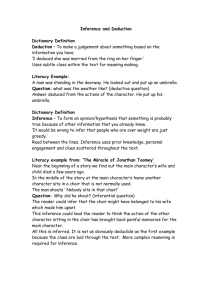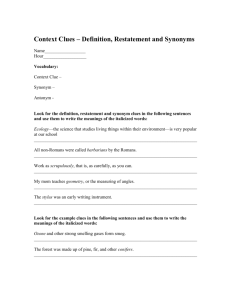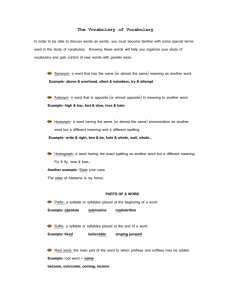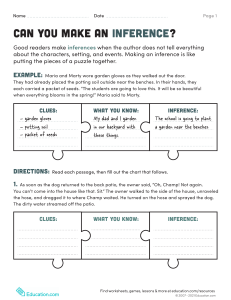Name English I Teacher Fall 2011 Date Resources Period
advertisement
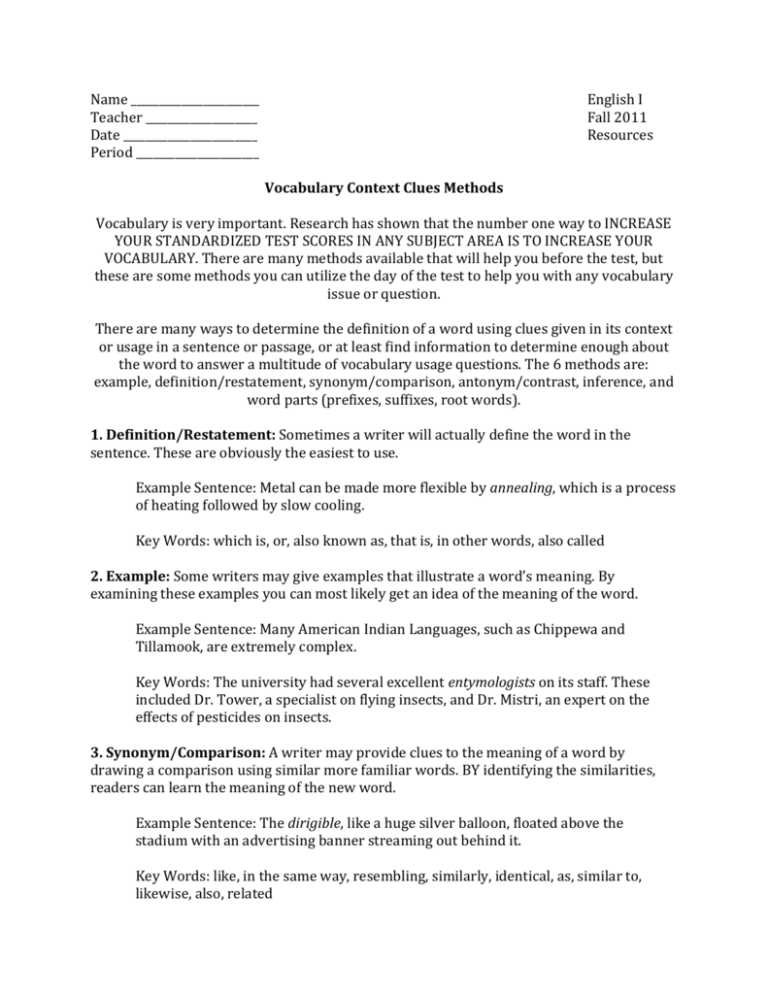
Name _______________________ Teacher ____________________ Date ________________________ Period ______________________ English I Fall 2011 Resources Vocabulary Context Clues Methods Vocabulary is very important. Research has shown that the number one way to INCREASE YOUR STANDARDIZED TEST SCORES IN ANY SUBJECT AREA IS TO INCREASE YOUR VOCABULARY. There are many methods available that will help you before the test, but these are some methods you can utilize the day of the test to help you with any vocabulary issue or question. There are many ways to determine the definition of a word using clues given in its context or usage in a sentence or passage, or at least find information to determine enough about the word to answer a multitude of vocabulary usage questions. The 6 methods are: example, definition/restatement, synonym/comparison, antonym/contrast, inference, and word parts (prefixes, suffixes, root words). 1. Definition/Restatement: Sometimes a writer will actually define the word in the sentence. These are obviously the easiest to use. Example Sentence: Metal can be made more flexible by annealing, which is a process of heating followed by slow cooling. Key Words: which is, or, also known as, that is, in other words, also called 2. Example: Some writers may give examples that illustrate a word’s meaning. By examining these examples you can most likely get an idea of the meaning of the word. Example Sentence: Many American Indian Languages, such as Chippewa and Tillamook, are extremely complex. Key Words: The university had several excellent entymologists on its staff. These included Dr. Tower, a specialist on flying insects, and Dr. Mistri, an expert on the effects of pesticides on insects. 3. Synonym/Comparison: A writer may provide clues to the meaning of a word by drawing a comparison using similar more familiar words. BY identifying the similarities, readers can learn the meaning of the new word. Example Sentence: The dirigible, like a huge silver balloon, floated above the stadium with an advertising banner streaming out behind it. Key Words: like, in the same way, resembling, similarly, identical, as, similar to, likewise, also, related 4. Antonym/Contrast: Writers sometimes provide clues to unfamiliar words by contrasting them with ones that are familiar. By determining what the new word does NOT mean you can get an idea of what it does mean. Example Sentence: Zinc, is a naturally-occurring element. Einsteinium, on the other hand, is not. Key Words: but, however, on the other hand, dissimilar, although, on the contrary, unlike, different 5. Inference: Some clues to word meanings are even harder to find. These require the reader to look “between the lines”. These are inferences. There are 3 types of inferences in these instances. A. Inference from main idea or supporting details B. Inference from cause and effect C. Inference from implied comparison or contrast Example Passage: You have only to turn on your radio to see how eclectic America’s musical tastes are. At any time of day you are sure to find jazz, rock, show tunes, and county songs. A twist of the dial may bring you “easy listening” music, a string quartet, a symphony, or an opera. Turn the dial again, and you may find electronic music. 6. Word Parts: Many words are made up of one or many word parts. You can increase your knowledge of new words by analyzing any word parts. There are 4 types of word parts. A. B. C. D. Prefix Suffix Base word Root word Example: unquestionable Prefix: un Base Word: question Suffix: able *Word Suffixes are especially useful as they can help you to determine what part of speech the word is. Many times when answering vocabulary questions you can make an educated guess about the correct answer, if you can determine the part of speech given or needed, EVEN IF YOU CANNOT DEFINE THE WORD. Use the chart provided to help you commit some of the common suffixes and their correlating part of speech to memory.

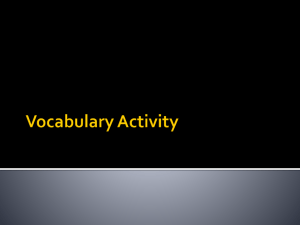
![Word Study [1 class hour]](http://s3.studylib.net/store/data/007905774_2-53b71d303720cf6608aea934a43e9f05-300x300.png)
